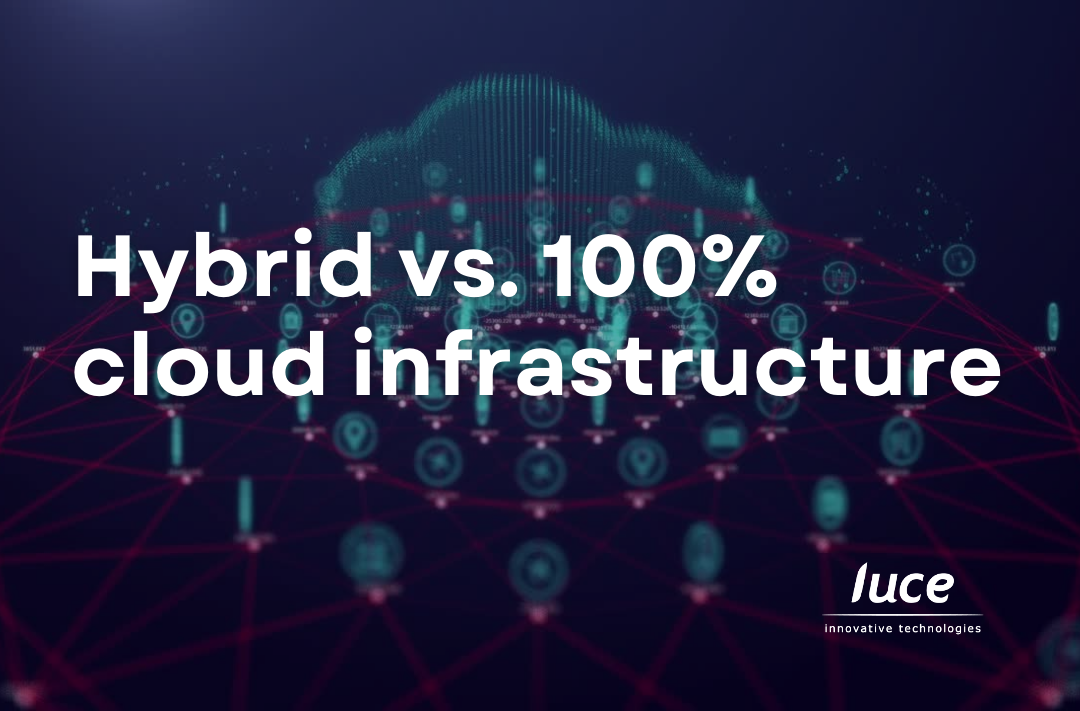
Hybrid vs. 100% cloud infrastructure
Migrating to the cloud is one of the most strategic decisions facing IT teams in all organisations. The question is no longer whether to make the leap, but how to do it: do companies go for a 100% cloud model, keep their systems on-premise or adopt a hybrid infrastructure that combines the best of both worlds?
On-Premise vs Cloud: the current business dilemma
Maintaining on-premise infrastructure means owning your own servers, with fixed costs for data centres, licences and maintenance. This provides full control and, in some cases of intensive 24/7 use, can be more cost-effective.
In contrast, the public cloud offers a pay-as-you-go model, with high scalability, reduced hardware maintenance costs and the ability to innovate faster.
According to Gartner, more than 85% of organisations will adopt a cloud-first strategy by 2025, using the cloud to deploy key technologies such as analytics, AI or critical applications.
Benefits of cloud computing for business
The cloud is not just a question of cost:
- Agility: allows environments to be deployed in hours rather than weeks.
- Instantaneous scalability: grow or shrink in capacity without physical investment.
- Remote collaboration: fundamental in hybrid working models.
- Advanced security: major vendors invest billions in cybersecurity.
- IT savings: studies show that moving loads to the cloud reduces operational expenditure by 20% to 40%.
A real case is that of PuroEGO, a Spanish fashion brand, which trusted Luce IT to migrate its traditional CPD to a private cloud. The result was a significant saving in infrastructure costs and a transparent migration process, with no impact on customers or processes.
When is a private or hybrid cloud best?
Not all organisations can or should migrate everything to the cloud. Sectors such as banking and public administration have regulatory requirementsthat require them to keep part of their systems in private or proprietary environments.
This is where the hybrid model emerges, combining public cloud with on-premise or private systems. In practice, many organisations keep their critical workloads – such as core banking or ERP – in in-house environments, while turning to the public cloud to absorb peaks in demand, deploy development environments or enable web services. In addition, they often take advantage of the cloud for backup and recovery tasks, reducing costs by 25-30% compared to the traditional alternative of duplicating a data centre.
Gradual migration strategy and use cases
Migrating does not mean turning one system off and another on overnight. The most effective strategy is to do it ina staggered manner, starting by identifying the most cloud-friendly applications, then moving on to test or development environments and, only when the process is consolidated, gradually extending the migration to critical loads.
Some typical hybrid use cases:.
- Backup and recovery in the cloud (cost reduction vs. duplicate data centres).
- Development and test environments in the cloud, with faster and more secure deployments.
- Back-up centres in the cloud that ensure business continuity;
The future is multi-cloud and hybrid
The decision between on-premise, cloud or hybrid is not unique: each company must assess its regulation, technological maturity and business objectives..
What is clear is that the future is multi-cloud and hybrid. A well-planned strategy allows you to maintain control over critical systems, take advantage of the flexibility and savings of the cloud and evolve towards more agile models without leaving behind the investments you have already made.
Are you evaluating migrating your infrastructure? At Luce IT we can help you design a cloud or hybrid migration strategy adapted to your reality, minimising risks and maximising benefits. Contact us and find out how our experience in banking, retail, logistics and tourism can boost your digital transformation.
Fuentes: https://www.techrepublic.com/article/85-of-organizations-will-be-cloud-first-by-2025-says-gartner
Luce IT, your trusted technology innovation company
The Luce story is one of challenge and non-conformity, always solving value challenges using technology and data to accelerate digital transformation in society through our clients.
We have a unique way of doing consulting and projects within a collegial environment creating “Flow” between learning, innovation and proactive project execution.
At Luce we will be the best by offering multidisciplinary technological knowledge, through our chapters , generating value in each iteration with our clients, delivering quality and offering capacity and scalability so they can grow with us.
>> The voice of our customers – Rated 9 in 2024
>> Master Plan 2025: Winning the game



